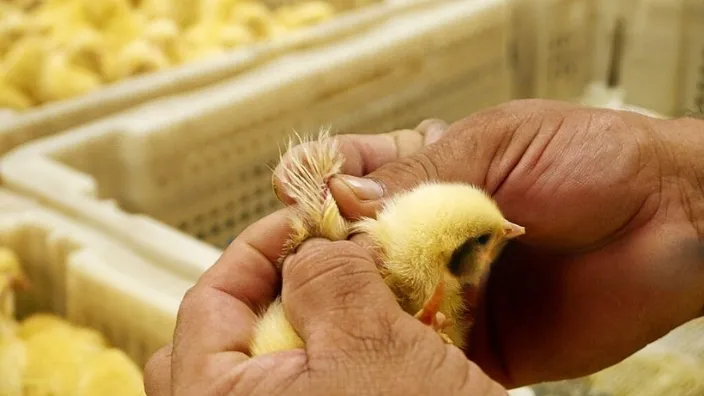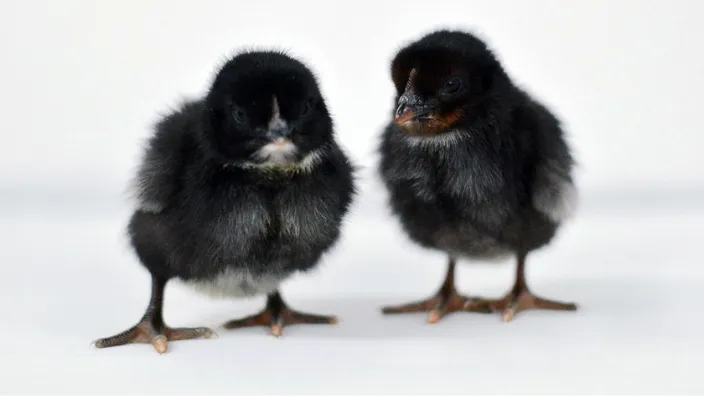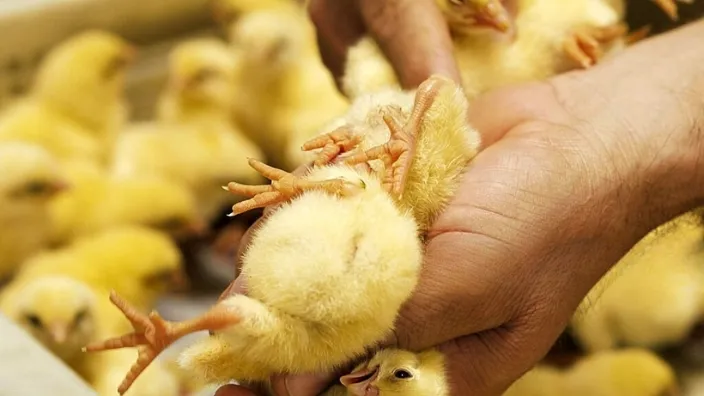If you are buying chicks which are sold as sexed, you should have proper knowledge of whether they are male or female. Poultry farms offer different prices for male and female chicks. A problem with them is that if you buy chicks luckily or unfortunately one or two out of them may be male means rooster.
If you cannot determine the sex here it is a treasure of knowledge for you on how to tell if a chick is male or female. Go through it thoroughly and get the benefits of it. Not only professionals but you also will easily examine if a chick is male or female.
Table of Contents
Simple Methods
Methods to determine the sex of a chick have been classified under four heads: -
- Self-Conducted DIY Test
- Observe Their Sex Drive
- Wait for weeks & See
- Seek Help
Self-Conducted DIY Test

These are the tests which can be performed by anyone and don’t require any specific expertise. Find below the key methods under this category.
Inspect Wing Feathers
Firstly, look at their wing feathers; it is the easiest way to determine the sex. Just hold gently a baby chick and keenly observe its feathers. Male check also called cockerel will possess uniform and regular-length feathers, and the edges will make a straight line. While female chick also known as pullet’s feathers will be of irregular length, the feather edges will make no straight line.
Recommended Reading: How to Tell if a Baby Bird is Dying
Examine their Colour
Through colour, you will also be able to inspect the sex of chicks. This is a relatively easy but not very reliable way. The colour of the male chick will be light, particularly the head, whereas the female chick’s head will be dark brown in colour. If there you observe any spots or stripes that will be brown or black. On the contrary that of males will be white or yellow.
Notice their Size
The third effective way is looking at their sizes but it cannot be assumed just after their birth. You will have to wait for two to three weeks for proper growth. The male chick's body size will be a little bit bigger than that of the female chick. Male chicks will grow healthier faster and will look bigger in size than females.
Observe the Wattles of Adult Chickens
The wattle-like comb also grows after 3rd week and acts as an indicator of sex. The wattle lies below the beak while the comb is on the head. The wattle of the male will be brighter or sometimes reddish in colour whereas that of the female will be yellow, grey or white.
This is the ordinary way of sex and is widely accepted. This occurs after the 10th week and you will have to wait till then. The common technique, not really a technique but nature is that a female chick will lay an egg while the male chick won’t.
Observe their Sex Drive
In order to conduct these tests, one should ponder on the sex cycle and the sexing patterns of a chick so as to know more about the gender of a chick. Find below some words about the tests: -
Try Vents Sexing
This method of sexing is not recommended for everyone, only professionals can do it on account of high risks. It can be done only with newly hatched chicks. Hold the newly hatched chick and push it down below the vent to open it. In order to do so you will be able to observe the sex organs. Males will have a bump or protrusion while females will haven’t any.
Consider Temperament
This is the most effective and common way but you will have to wait for more than a month. Chicks growing will time show some behaviours which symbolize the sex? The chick will develop some common behaviours which are stereotypically associated with maleness and femaleness. Males fight and do not fight while females fear and run away while detecting any danger.
Get a “sex link” Chick to Find it Male or Female

This method is rarely used by professionals, they use a technique of breeding sex-specific colour patterns during hatching. However, there is a high degree of accuracy with which they confidently claim about sexing. For instance, Red Stars assumes it is a sex-link breed. Males in this scenario will be of Yellow-golden colour whereas females will be reddish-golden in colour.
Wait for Weeks & See
For these tests, one is supposed to wait for a few weeks so the gender of the chick becomes apparent to proceed further. These tests are considered best for the reason of being inexpensive and more conclusive. Key tests are as follows: -
Wait until the Chicks are 6 Weeks old
If you are unable to perform all the mentioned ways, wait for 6 weeks and it will be easy to determine sexing. Among other things, the chick will develop some common behaviours which are stereotypically associated with maleness and femaleness.
Male chicks will be brave, wise and more likely to survive in every situation while females will lack such behaviors. Other behaviours are growing comb, wattle, saddle feathers and others through which sexing will be performed.
Observe their Comb Development at 6 Weeks
The comb is an indicator which reveals the sex; the comb develops after 3rd or 4th week. Male chicks will have a taller comb on their head. The colour of the male comb will be darker in colour.
The case is different for female chicks, with smaller comb and light in colour. Remember that the comb develops after three weeks.
Look at the Saddle Feathers
The saddle feathers are also a signifier of the sex but this works after 8 to 10 weeks. Female saddle feathers are round in shape while males are long and pointed. This is an easy way of determining the sex, every ordinary man can do it.
Seek Help from physician

Tests under this category involve examination and determination by the professional. Having examined the physical features of a newly born chick, the physician can provide an opinion regarding the gender of the chick. For this category, the following methods are usually applied:
Ask a Professional
If you are buying a lot of chicks or thinking of poultry you are directed to hire a professional. Only a professional can save you from loss. They have proper knowledge and are experts in sex. They will look after the chicks with extra care.
Do Laser Spectroscopy
The laser spectroscopy is done on a big scale and only professionals can perform it. It is widely adopted for commercial purposes in industry or large poultries. They pass a laser through eggs and determine whether the hatched chick will be female or male.
Rely on a Method with 50% + Accuracy
While studying all the methods if you are facing any difficulty in the sexing process then the last option is to go with a method of more than 50% accuracy. If the success ratio or accuracy of a method is more than all others adopt it without hesitation.
Common Sexing Methods

In addition to the above, here are some common effective ways of sexing: -
a. Legs:
While looking at the legs of 4 or 5-week-old chicks you will notice a spurt and paws. Males are more likely to develop legs of bigger size than that of females.
b. Posture:
Generally, the posture also determines the sex. It is a common observation that males being dominant and stronger show some bold postures as compared to females. The same is the case with chicks, the males among them adopt an upright posture than female chicks. Note that the chicks will be much older and can be called roosters and hens.
c. Crowing:
Like egg lying, this is also very obvious for sexing. After maturity males start crowing. However, it cannot prove to be very useful because sometimes female chicks we mean hens also start crowing.
d. Gold top Bantam:
The golden top bantam as an indicator of sexing helps you in clearing your confusion. You expect male chicks of yellow colour with small patches of black (bottom). On the contrary, females will be of golden brown colour with small black patches (top),
e. Blacktails:
Watch the blacktails of newly hatched eggs for sexing. If these are yellow you are having male chicks while females have golden brown blacktails.
f. Hackle Feathers & Sickle Feathers:
The hackle and sickle feathers are the main sex indicators. The former will start developing after 4 to 6 months on the neck region and tail. If you notice long and pointy feathers that will be male. If the hackle feathers are round it is female.
Talking about the sickle feathers, these also develop in the same age as the hackle. Male chicks will have long, curvy, upright feathers at the top of the tail. While females have rounded, uniform sized and less showy feathers.
Behavioral Differences / Temperament
Let’s talk about the temperament of male and female chicks. The male and female behaviours differ widely and can be useful in sexing.
1.Cockerel (male chick) behaviour Cockerel, the male chick, will be taller and bigger in size. If they detect any danger they will resist and react, they also fight arrogantly to be the best among other roosters. They may also try tidbit ting, scratching, dancing and clucking food.
They show some unique behaviours to their favourite female chicks and want to share food with them. Compared to hens they can be easily domesticated, and show friendly gestures.
At their mature stage, their big indication is that they begin using their vocal cords and try voicing. We are talking about crowing, they crow in a louder voice. People often use roosters for fights and make pennies by doing so. It is a sin, fighting innocent birds and hurting them is a low standard of humanity.
2. Pullet behavior As a common observation females show submissiveness. They start laying eggs in their maturity which is a great sign of sex. They are fragile and do not participate in fighting. If roosters come they leave their food and run away. They are kind and look after their hatched chicks.
Relatively they do not develop their vocal cords and cannot crow like roosters. They squat if they want sex and show squatting as a sign of mating with male friends. They also exhibit behaviours of males like crowing, tidbitting, and giving warning calls in the absence of roosters.
False Beliefs about Sexing a Chick

There are some stereotypes that people believe as ways of sexing but actually are wives tales and cannot be relied on. People used to adopt such methods but with the advancement of technology, these ways are falsified and are no longer used: -
- The Shape of the Egg
- Turning a Chick Upside Down
- The Egg Floating Test
- Egg Candling
- Weight on a String
Some Common Practices
Amongst other methods we have discussed, one can also make an effort to check chick is male or female wing sexing, sex linked chickens to identify male. Hen feathered, hackle feathers, feather sexing, auto sexing, sickle feathers alongwith certain breeds can also be used to determine the gender of chicks.
It is also worth mentioning that most breeds when cross breeding can be judged from sex based activities, color patterns, weeks old etc.
Conclusion
To summarize, if you are going to buy chicks but think of how to tell if a chick is male or female, just consider some methods of high accuracy. Keenly observe chicks, if you find larger bodies, uniform wing feathers, big spurt, light-coloured heads, bumps or protrusion, taller comb and crowing then you are having male chicks.
For females, the case is totally opposite, with small bodies, no uniform feathers, small spurt, dark-coloured heads, and smaller combs. Besides, you can have any of the gives tests and trials conducted to know finally the gender of a chick.
Meanwhile, false beliefs' be ignored and the tips given in the article may be looked into for the purposes of self examination, observing behaviour or getting supports from the professional.
FREQUENTLY ASKED QUESTIONS
How to tell if a chick is male or female?
You can easily tell by keenly observing chicks, if you find larger bodies, uniform wing feathers, big spurts, light-colored heads, bumps or protrusions, taller comb and crowing then you are having male chicks. For females, the case is totally opposite, small bodies, no uniform feathers, small spurt, dark coloured head, and smaller comb.
Is vent sexing a good method?
This method of sexing is not recommended for everyone, only professionals can do it on account of high risks. It can be done only with newly hatched chicks. Hold the newly hatched chick and push it down below the vent to open it. In order to do so you will be able to observe the sex organs. Males will have a bump or protrusion while females will haven’t any.
How to tell if a chick is male or female by considering temperament?
This is the most effective and common way but you will have to wait for more than a month. Chicks growing will time show some behaviours which symbolize sex. The chick will develop some common behaviours which are stereotypically associated with maleness and femaleness. Males fight and do not fight while females fear and run away while detecting any danger.
What are the false beliefs of sexing a chick?
The false beliefs about sexing chicks are the Shape of the Egg, turning a chick upside down, the egg floating test and egg candling. There are some myths that people believe as ways of sexing but actually are wives tales and cannot be relied on. People used to adopt such methods but with the advancement of technology, these ways are falsified and are no longer used.
Which method is more reliable and accurate among all?
Among all the methods if you are facing any difficulty in the sexing process then the last option is to go with a method of more than 50% accuracy. If the success ratio or accuracy of a method is more than all others so adopt it without hesitation. It’s up to you if you go with one or other.


















